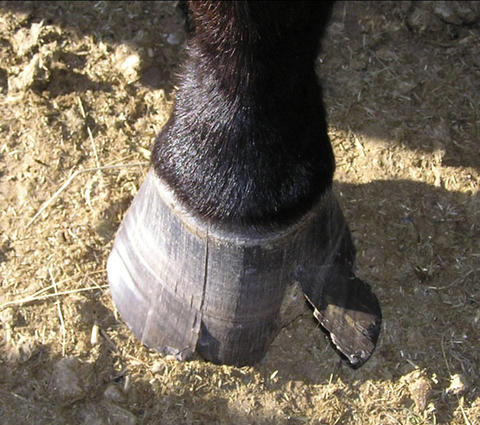
Use these four inexpensive techniques to protect your horse’s hooves, braid their mane, treat their scars and more.
Temporary Hoof Repair
Chunks of missing hoof wall or deep cracks in your horse’s foot will only get deeper and larger while you wait for the next farrier visit. Dirt, arena sand and other debris erode the edges of the defect, and your daily cleaning of the area will only make the hole bigger. Use the edge of your shoeing rasp to make a horizontal notch in the hoof wall above the crack to stop it from going further up the wall. Thoroughly clean all the dirt out of the defect using an old toothbrush. When the area is dry, fill it in with wood filler purchased at your local hardware store. It will be in a small can and consists of ground-up wood/plastic mixed with glue. Press the wood filler in firmly and let it dry thoroughly before your horse goes outdoors or back in his stall. Dry time is 30 to 45 minutes depending on how big the patch is, so give your horse a good grooming while the patch “sets up.”
Winter Hoof Protection
If you live in an area that has snow in the winter, you know all about those big clods of icy snow that get packed into your horse’s feet. These can be quite dangerous because the horse can easily slip and fall due to a lack of traction between the hoof/shoe and the ground. He’s also at risk for twisting or breaking an ankle because of the instability. Again, visit the hardware store, and purchase a paste wax for wood floors. You can also use Butcher’s Wax, also called bowling alley wax. It costs a few dollars and comes in a round, flat can. Before you turn your horse out, pick out and brush his feet clean. Using your fingers, generously rub some wax all over the sole and frog, or the hoof pad itself if he has pads on his front feet. The wax really helps the ice clods fall out of the feet. And nothing ever sticks to the treated pads. In between uses, store the wax in a heated room so it doesn’t freeze and remains soft enough to spread.
Good for Mane Braiding & More
Even if you braid your horse’s mane with yarn, or never braid at all, keep a supply of black braiding elastics in your tack room. Store them in an old margarine container to keep them from drying out. Use them on your tack so that your keepers stay in place. (Loose ones tend to slide down leaving a floppy, messy looking strap above.) You can also use them as extra keepers, such as on the back of the noseband when the free end of the strap is very long.
Treating Hairless Scars
Baby oil is great to put on hairless scars before you go in the show ring. It darkens the skin, making the scars less noticeable, especially on bay or black horses.
Related Articles & Free Email Newsletter Sign Up
6 Things to Do When You Can’t Ride Your Horse
How to Deal With A Horse Rearing or Pulling




Comment here